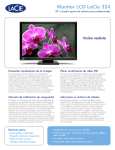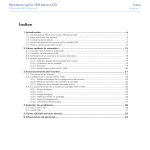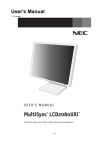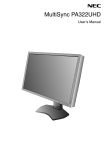Download 300 series (Gen 2) User Manual
Transcript
LaCie 300 Series LCD Monitor User Manual Table of Contents page Table of Contents Forward Safety Precautions and Maintenance Health and Ergonomic Precautions Environmental Regulations Manufacturer’s Recycling and Energy Information 3 4 5 6 Monitor Specifications 7 1. Introduction to Your LaCie 300 Series LCD Monitor 1.1. 300 Series Monitor Capabilities 1.2. Minimum System Requirements 1.3. Package Content 8 8 9 9 2. Installing Your LaCie 300 Series LCD Monitor 10 3. Using Your LaCie 300 Series LCD Monitor 3.1. Physical Adjustments 3.1.1. Raise and lower monitor screen 3.1.2. Screen tilt 3.1.3. Screen rotation 3.1.4. Swivel 3.1.5. Remove monitor stand for mounting 3.1.6. Flexible arm installation 13 13 13 13 14 14 15 16 4. OSD (On-Screen Display) Control Button Functions 4.1. Brightness/Contrast Controls 4.2. Auto Adjust (Analog input only) 4.3. Image Controls 4.4. Color Control Systems 4.5. Tools 1 4.6. Menu Tools 4.7. Information 4.8. OSD Warnings 4.9. Advanced Menu Functions 4.10. Using the Auto Brightness Function 17 18 18 18 20 20 23 24 25 25 34 5. Troubleshooting 36 6. Contacting Customer Support 6.1. LaCie Technical Support Contacts 38 39 7. Warranty Information 40 LaCie 300 Series LCD Monitor User Manual Copyrights Copyright © 2006 LaCie. All rights reserved. No part of this publication may be reproduced, stored in a retrieval system, or transmitted in any form or by any means, electronic, mechanical, photocopying, recording or otherwise, without the prior written consent of LaCie. Changes The material in this document is for information only and subject to change without notice. While reasonable efforts have been made in the preparation of this document to assure its accuracy, LaCie assumes no liability resulting from errors or omissions in this document, or from the use of the information contained herein. LaCie reserves the right to make changes or revisions in the product design or the product manual without reservation and without obligation to notify any person of such revisions and changes. FCC Declaration of Conformity: LaCie 300 Series LCD Monitor Tested To Comply With FCC standards For Home of Office Use NOTE: This equipment has been tested and found to comply with the limits for a Class B digital device, pursuant to Part 15 of the FCC Rules. These limits are designed to provide reasonable protection against harmful interference in a residential installation. This equipment generates, uses and can radiate radio frequency energy and, if not installed and used in accordance with the instructions, may cause Forward page harmful interference to radio communications. However, there is no guarantee that interference will not occur in a particular installation. If this equipment does cause harmful interference to radio or television reception, which can be determined by turning the equipment off and on, the user is encouraged to try and correct the interference by one or more of the following measures: • Reorient or relocate the receiving antenna. • Increase the separation between the equipment and receiver. • Connect the equipment into an outlet on a circuit different from that to which the receiver is connected. • Consult the dealer or an experienced radio/TV technician for help. • Use only shielded cables to connect I/O devices to this equipment. Use the attached specified cables with the LaCie 300 Series color monitor so as not to interfere with radio and television reception. 1. The power supply cord you use must have been approved by and comply with the safety standards of U.S.A. and meet the following condition. Power supply chord Non shield type, 3-conductor Length 2.0 m Plug shape (USA) 2. Please use the supplied shielded video signal cable, 15-pin mini D-SUB to DVI-A cable or DVI-D to DVI-D cable. Use of other cables and adapters may cause interference with radio and television reception. U.S. Responsible Party: LaCie, LTD Address: 22985 NW Evergreen Pkwy Hillsboro, OR 97124 Tel. No.: (503) 844-4503 Manufacturer’s Declaration for CE Certification We, LaCie, solemnly declare that this product conforms to the following European standards: • EN60950-1, EN61000-3-2 • EN61000-3-3, EN55024 With reference to the following conditions: • 73/23/EEC Low Voltage Directive • 89/336/EEC EMC Directive LaCie, Inc. 17, Rue Ampère 91349 Massy Cedex, France CAUTION: Modifications not authorized by the manufacturer may void the user’s authority to operate this device. Modifications not authorized by the manufacturer may void the user’s authority to operate this device. CAUTION: A shielded-type power cord is required in order to meet FCC emission limits and also to prevent interference to the nearby radio and television reception. It is essential that only the supplied power cord be used. LaCie 300 Series LCD Monitor User Manual Safety Precautions and Maintenance page Safety Precautions and Maintenance • DO NOT OPEN THE MONITOR. There are no user serviceable parts inside and opening or removing covers may expose you to dangerous shock hazards or other risks. Refer all servicing to qualified service personnel. qualified personnel under the following conditions: • Do not spill any liquids into the cabinet or use your monitor near water. • If the monitor has been exposed to rain or water. • Do not insert objects of any kind into the cabinet slots, as they may touch dangerous voltage points, which can be harmful or fatal or may cause electric shock, fire or equipment failure. • If the monitor has been dropped or the cabinet damaged. • Do not place any heavy objects on the power cord. Damage to the cord may cause shock or fire. • If glass is broken, handle with care. • Do not place this product on a sloping or unstable surface, as the monitor may fall, causing serious damage. • Do not place any objects onto the monitor and do not use the monitor outdoors. • The inside of the fluorescent tube located within the LCD monitor contains mercury. Please follow the bylaws or rules of your municipality to dispose of the tube properly. • Do not bend power cord. • Do not use monitor in high temperatured, humid, dusty, or oily areas. • Do not cover vent on monitor. Immediately unplug your monitor from the outlet and refer servicing to • When the power supply cord or plug is damaged. • If liquid has been spilled, or objects have fallen into the monitor. • If the monitor does not operate normally by following operating instructions. • If monitor or glass is broken, do not come in contact with the liquid crystal and handle with care. • Allow adequate ventilation around the monitor so that heat can properly dissipate. Do not block ventilated openings or place the monitor near a radiator or other heat sources. Do not put anything on top of monitor. • The power cable connector is the primary means of detaching the system from the power supply. The monitor should be installed close to a power outlet which is easily accessible. • Handle with care when transporting. Save packaging for transporting. • Image Persistence: Please be aware that LCD Technology may experience a phenomenon known as Image Persistence. • Image Persistence occurs when a residual or “ghost” image of a previous image remains visible on the screen. Unlike CRT monitors, LCD monitors’ image persistence is not permanent, but constant images being displayed for a long period of time should be avoided. To alleviate image persistence, turn off the monitor for as long as the previous image was displayed. For example, if an image was on the monitor for one hour, the monitor should be turned off for one hour to erase the image. • When operating the LaCie 300 Series LCD Monitor with a 220-240V AC power source in Europe, use the power cord provided with the monitor. • In the UK, a BS approved power cord with a moulded plug has a Black (five Amps) fuse installed for use with this equipment. • If a power cord is not supplied with this equipment please contact your supplier. • When operating the LaCie 300 Series LCD Monitor with a 220-240V AC power source in Australia, use the power cord provided with the monitor. If a power cord is not supplied with this equipment please contact your supplier. • For all other cases, use a power cord that matches the AC voltage of the power outlet and has been approved by and complies with the safety standard of your particular country. LaCie 300 Series LCD Monitor User Manual Health and Ergonomic Precautions page Health and Ergonomic Precautions Correct placement and adjustment of the monitor can reduce eye, shoulder and neck fatigue. Check the following when you position the monitor: • For optimum performance, allow 20 minutes for warm-up. • Adjust the monitor height so that the top of the screen is at or slightly below eye level. Your eyes should look slightly downward when viewing the middle of the screen. • Position your monitor no closer than 40 cm and no further away than 70 cm from your eyes. The optimal distance is 50 cm. • Rest your eyes periodically by focusing on an object at least 20 feet away. Blinkoften. • Adjust the monitor’s brightness and contrast controls to enhance readability. • Position the monitor at a 90° angle to windows and other light sources to minimize glare and reflections. Adjust the monitor tilt so that ceiling lights do not reflect on your screen. • Use a document holder placed close to the screen. • If reflected light makes it hard for you to see your screen, use an antiglare filter. • Clean the lcd monitor surface with a lint-free, non-abrasive cloth. Avoid using any cleaning solution or glass cleaner! To maximize ergonomics benefits, we recommend the following: • Adjust the brightness until the background raster disappears. • Do not position the contrast control to its maximum setting. • Use the preset size and position controls with standard signals. • Position whatever you are looking at most of the time (the screen or reference material) directly in front of you to minimize turning your head while you are typing. • Avoid displaying fixed patterns on the monitor for long periods of time to avoid image persistence (after-image effects). • Use the preset color setting. • Use non-interlaced signals with a vertical refresh rate between 60-75 hz. • Do not use primary color blue on a dark background, as it is difficult to see and may produce eye fatigue to insufficient contrast. LaCie 300 Series LCD Monitor User Manual Environmental Regulations page Environmental Regulations Congratulations! You have just purchased a TCO’03 approved and labeled product! Your choice has provided you with a product developed for professional use. Your purchase has also contributed to reducing the burden on the environment an to the further development of environmentally adapted electronics products. ■ Why do we have environmentally labeled computers? In many countries, environmental labeling has become an established method for encouraging the adaptation of goods to the environment. The main problem, as far as computers and other electronics equipment are concerned, is that environmentally harmful substances are used both in the products and during the manufacturing. Since it has not been possible for the majority of electronics equipment to be recycled in a satisfactory way, most of these potentially damaging substances sooner or later enter Nature. There are also other characteristics of a computer, such as energy consumption levels, that are important from the viewpoints of both the work (internal) and natural (external) environments. Since all methods of conventional electricity generation have a negative effect on the environment (acidic and climateinfluencing emissions, radioactive waste, etc.), it is vital to conserve energy. Electronics equipment in offices consume an enormous amount of energy since they are often left running continuously. ■ What does labeling involve? This product meets the requirements for international and environmental labeling of personal computers. The requirements cover a wide range of issues, including: environment, ergonomics, usability, emission of electrical and magnetic fields, energy consumption and electrical and fire safety. The environmental demands concern restrictions on the presence and use of heavy metals, brominated and chlorinated flame retardants, CFCs (freons) and chlorinated solvents, among other things. The product must be prepared for recycling and the manufacturer is obliged to have an environmental plan which must be adhered to in each country where the company implements its operational policy. The energy requirements include a demand that the computer and/or display, after a certain period of inactivity, shall reduce its power consumption to a lower level in one or more stages. The length of time to reactivate the computer shall be reasonable for the user. Labeled products must meet strict environmental demands, for example, in respect of the reduction of electric and magnetic fields, physical and visual ergonomics and good usability. ■ Environmental Requirements Flame retardants Flame retardants are present in printed circuit boards, cables, wires, casings and housings. In turn, they delay the spread of fire. Up to thirty percent of the plastic in a computer casing can consist of flame retardant substances. Most flame retardants contain bromine or chloride and these are related to another group of environmental toxins, PCBs, which are suspected to give rise to severe health effects, including reproductive damage in fish-eating birds and mammals, due to the bio-accumulative* processes. Flame retardants have been found in human blood and researchers fear that disturbances in fetus development may occur. Plastic components weighing more than 25 grams must not contain flame retardants with organically bound chlorine and bromine. Flame retardants are allowed in the printed circuit boards since no substitutes are available. Lead** Lead can be found in picture tubes, display screens, solders and capacitors. Lead damages the nervous system and in higher doses, causes lead poisoning. Requirements permit the inclusion of lead since no replacement has yet been developed. Cadmium** Cadmium is present in rechargeable batteries and in the color-generating layers of certain computer displays. Cadmium damages the nervous system and is toxic in high doses. Requirements state that batteries, the color-generating layers of display screens and the electrical or electronics components must not contain any cadmium. LaCie 300 Series LCD Monitor User Manual Mercury** Mercury is sometimes found in batteries, relays and switches, Mercury damages the nervous system and is toxic in high doses. Requirements state that batteries may not contain any Mercury. It also demands that no mercury is present in any of the electrical or electronics components associated with the display unit. CFCs (freons) CFCs (freons) are sometimes used for washing printed circuit boards. CFCs This symbol on the product or on its packaging indicates that this product must not be disposed of with your other household waste. Instead, it is your responsibility to dispose of your waste equipment by handing it over to Environmental Regulations page break down ozone and thereby damage the ozone layer in the stratosphere, causing increased reception on Earth of ultraviolet light with consequent increased risks of skin cancer (malignant melanoma). The relevant requirement; Neither CFCs nor HCFCs may be used during the manufacturing and assembly of the product or its packaging. *Bio-accumulative is defined as substances which accumulate within living organisms. **Lead, Cadmium and Mercury are heavy metals which are bio-accumulative. a designed collection point for the recycling of waste electrical and electronic equipment. The separate collection and recycling of your waste equipment at the time of disposal will help to conserve natural resources and ensure that it is recycled in a manner that protects human health and the environment. For more information about where you can drop off your waste equipment for recycling, please contact your local city office, your household waste disposal service, or the shop where you purchased the product. Manufacturer’s Recycling and Energy Information LaCie is strongly committed to environmental protection and sees recycling as one of the company’s top priorities in trying to minimize the burden placed on the environment. We are engaged in developing environmentally friendly products, and always strive to help define and comply with the latest independent standards from agencies. Recycling programs information: Sweden - http://www.el-retur.se Germany - http://www.recyclingpartner.de/ Holland - http://www.mirec.nl/ Japan - http://www.diarcs.com/ Energy saving: This monitor features an advanced energy saving capability. When a VESA Display Power Management Signaling (DPMS) Standard signal is sent to the monitor, the Energy Saving mode is activated. The monitor enters a single Energy Saving mode. Mode Power consumption LED color Normal operation 46W (319), 50W (320/321) Blue Energy saving mode Less than 1W Amber Off mode Less than 1W N/A LaCie 300 Series LCD Monitor User Manual Monitor Specifications page Monitor Specifications Technology: Diagonal display: Active Display: Resolution: Pixel pitch: Color depth: Gamma correction: Luminance: Contrast ratio: Response time: Viewing angles: Connections: Power consumption: In power save mode Weight: Weight with stand: Box weight: Box dimensions: Ergonomy: Operating Temp.: Humidity: Altitude: Storing Temp.: Storing Humidity: Storing Altitude: Certifications: Warranty: 319 LCD Monitor 320 LCD Monitor 321 LCD Monitor S-IPS A-TW-IPS SA-SFT 376.3 (H) x 301.1 (V) mm 408 (H) x 306 (V) mm 432 (H) x 324 (V) mm 19.0” (48 cm) 20.1” (51 cm) 21.0” (53.3 cm) 720 x 400 at 70 Hz to 85 Hz; 640 x 480 at 60 Hz to 85 Hz; 800 x 600 at 56 Hz to 85 Hz; 832 x 624 at 75 Hz; 1024 x 768 at 60 Hz to 85 Hz; 1152 x 864 at 70 Hz to 85 Hz; 1152 x 870 at 75 Hz; 1280 x 960 at 60 Hz; 1280 x 1024 at 60 Hz to 85 Hz (Optimal resolution for LaCie 319); 1200 x 1600 at 60 Hz; 1600 x 1200 at 60 Hz (Optimal resolution for LaCie 320 and 321, not supported for 319); some systems may not support all modes listed. 0.294 mm 0.255 mm 0.270 mm 270 cd/m2 (typical) 1 280 cd/m2 (typical) 1 250 cd/m2 (typical) 1 Rise time + Fall time : 18ms (typical) Rise time + Fall time : 16ms (typical) Rise time + Fall time : 20ms (typical) 16,777,216 12 bit 600:1 (typical) 178° 700:1 (typical) Mini D-sub 15 pin, DVI-I (analog or digital), DVI-D (digital) 500:1 (typical) 46 W (typical) 50 W (typical) 50 W (typical) 6.3 kg 7.0 kg 8.2 kg 13.4 kg 14.2 kg 16.3 kg <1W 9.0 kg 9.7 kg 10.9 kg (WxHxD) 508 x 600 x 321 mm (WxHxD) 558 x 641 x 325 mm (WxHxD) 620 x 685 x 370 mm Up/down: 30° to -5°; left/right: 170° to 170°; clockwise: 90°; height adjustment: 150 mm 5°C to 35°C/41°F to 95°F 30% to 80% 0 to 10,000 feet / 0 to 3,048 m -10°C to 60°C / 14°F to 140°F 10% to 85% 0 to 40,000 feet / 0 to 12,192 m CE, FCC-B, TÜV-Ergonomie, TÜV-GS, TCO’03, EnergyStar, C-Tick, GOST-R, c-UL, UL, VCCI-B, VESA DDC 2B, DDC-CI US: 3-year limited; Europe: 3-year advance swap 1 Values for when the UNIFORMITY function is OFF. LaCie 300 Series LCD Monitor User Manual 1. Introduction to Your LaCie 300 Series LCD Monitor Thank you for purchasing the LaCie 300 Series LCD Monitor. Designed for serious graphics professionals, these LCD monitors feature 12-bit gamma correction to meet the challenge of today’s color needs. 1.1. 300 Series Monitor Capabilities • IPS (LaCie 319), A-TW-IPS (LaCie 320) and SASFT-IPS (LaCie 321) panel technologies offer the best available LCD color accuracy, with a good balance between Contrast, Brightness and Expansive Viewing Angles of 178°. • Improved uniformity: Each panel is individually tested at the factory and corrected to ensure that brightness and chromaticity are uniform across the screen. • 12-bit gamma correction: An embedded Integrated Circuit containing 12-bit color correction tables enables true hardware calibration of the display. • LaCie blue eye pro software included: This complete yet easy-to-use calibration software offers professional grade calibration and ICC profiling of the monitors on Mac OSX, Windows XP, 2000, and XP64. • Monitor easyHood included: The black, anti-reflective velvet material that lines the easyHood reduces ambient light glare and ensures document colors are accurately seen by the user. • Ergonomic stand enabling Height- Swivel- Tilt- and Pivot- adjustments • Pivot Pro software for Windows included: In conjunction with the monitor stand’s mechanical Pivot adjustment, this software allows the user to effectively rotate the desktop and work in Landscape mode. • Portability handle and quick-release stand make your LaCie 300 Series Monitor easy to carry. Introduction page LaCie 300 Series LCD Monitor User Manual Introduction page 1.2. Minimum System Requirements ■ Hardware Requirements • DVI graphics board required for automatic hardware calibration 1.3. Package Content Your LaCie 300 Series LCD monitor should contain the following: 1 LaCie 300 Series LCD Monitor with tilt/ swivel/pivot/height adjustable stand 2 Power cord 3 Screws (to mount the monitor to a flexible arm) 4 Cable cover 5 Video signal cable (15-pin mini D-SUB male to DVI-A) 6 Video signal cable (DVI-D to DVI-D cable) 7 easyHood 8 LaCie Utilities CD-ROM (includes User Manual and blue eye pro calibration software) 9 1 2 3 4 6 5 8 7 LaCie 300 Series LCD Monitor Version 2.0 LaCie User Manual Manuel Utilisateur • Guída Utente • Handbuch • ユーザー マニュアル Manual De Instrucciones • Gebruikershandleiding ICC Profiles Included Profiles ICC inclus • Profili ICC inclusi ICC Profile inbegriffen • Perfiles ICC incluidos 10 9 2006 LaCie 300 Series LCD Monitor Quick Install Guide 10 Pivot Pro Software Quick Install Guide Important Info: Please save your packaging. In the event that the monitor should need to be repaired or serviced, it must be returned in its original packaging. LaCie 300 Series LCD Monitor User Manual Installing Your LaCie Monitor page 10 2. Installing Your LaCie 300 Series LCD Monitor Mac Cable Adaptor (not included) Figure A Figure B To attach the LCD monitor to your system, follow these instructions: 1. Turn off the power to your computer. 2. For the PC or MAC with DVI digital output: Connect the DVI signal cable to the connector of the display card in your system (Figure A). Tighten all screws. For the PC with Analog output: Connect the 15-pin mini D-SUB to DVI-A signal cable to the connector of the display card in your system (Figure B). For the MAC: Connect the Macintosh cable adapter to the computer, then attach the 15-pin mini D-SUB signal cable to the Macintosh cable adapter (Figure C). Figure C Technical note: Some Macintosh systems do not require a Macintosh cable adapter. LaCie 300 Series LCD Monitor User Manual page 11 30° Tilt Highest Stand Position DVI-D Installing Your LaCie Monitor DVI-I D-SUB Figure D Figure E Figure F 3. Place hands on each side of the monitor to tilt the LCD panel to a 30-degree angle and lift up to the highest position (Figure D). 4. Connect all cables to the appropriate connectors (Figure D). 5. To keep the cables neatly organized, place them into the cable management system that is built into the stand. CAUTION: Incorrect cable connections may result in irregular operation, damage display quality/components of LCD module and/or shorten the module’s life. • Place the D-Sub cable (not included) and the power cable into the specific hooks as indicated (Figure E). • Place the DVI cable and the 15-pin mini D-Sub to DVI-A cable into the hooks as indicated (Figure F). • When using the monitor in Portrait mode, place the DVI cable and the 15-pin mini D-Sub to DVI-A cable into the hooks as indicated (Figure G). 6. Make sure all cables are resting flat against the stand (Figure F). Please check Tilt, Rise and Lower monitor screen and screen rotation when you manage cables. Figure G LaCie 300 Series LCD Monitor User Manual Installing Your LaCie Monitor page 12 Figure H 7. Hold all cables firmly and place the cable cover onto the stand (Figure H). To remove the cable cover, lift the cover off as shown in Figure H. 8. Connect one end of the power cord to the AC inlet on the back of the monitor and the other end to the power outlet. Figure I Technical note: Please refer to Caution section of this manual for proper selection of AC power cord. 9. The Vacation Switch on the left side of the monitor must be turned on. Turn on the monitor with the front power button (Figure J) and the computer. Technical note: The Vacation Switch is a true on/off switch. If this switch is on the OFF position, the monitor cannot be turned on using the front button. DO NOT switch on/off repeatedly. 10. No-touch auto adjust automatically adjusts the monitor to optimal settings upon initial setup for most timings. For further adjustments, use the following OSD (on-screen display) controls: • Auto Contrast (Analog input only) • Auto Adjust (Analog input only) Refer to the page 17, OSD Control Button Functions, for a full description of these OSD controls. Vacation Switch Power Button Figure J LaCie 300 Series LCD Monitor User Manual Using Your LaCie Monitor page 13 3. Using Your LaCie 300 Series LCD Monitor 3.1. Physical Adjustments ■ 3.1.1. Raise and lower monitor screen Figure A The monitor may be raised or lowered in either Portrait or Landscape mode. To raise or lower screen, place hands on each side of the monitor and lift or lower to the desired height (Figure A and B). Figure B Technical note: Handle with care when raising or lowering the monitor screen. ■ 3.1.2. Screen tilt Grasp top and bottom sides of the monitor screen with your hands and adjust the tilt as desired (Figure C). Technical note: Handle with care when tilting the monitor screen. Figure C LaCie 300 Series LCD Monitor User Manual Using Your LaCie Monitor page 14 ■ 3.1.3. Screen rotation Figure D Before rotating, the screen must be raised to the highest level to avoid knocking the screen on the desk or pinching with your fingers. To raise the screen, place your hands on each side of the monitor and lift up to the highest position (page 13, figure B). To rotate the screen, place hands on each side of the monitor screen and turn clockwise from Landscape to Portrait or counterclockwise from Portrait to Landscape (Figures D and E). Figure E Mac Users Portrait mode requires a high end graphic board such as the ATI Radeon x800 or internal ATI graphic chip. PC Users Use the Pivot Pro software that ships with your LaCie 300 series monitor. To rotate the OSD menu between landscape and portrait, refer to “Controls” section. ■ 3.1.4. Swivel Grasp both sides of the monitor screen with your hands and adjust the swivel as desired (Figure F). Figure F LaCie 300 Series LCD Monitor User Manual Using Your LaCie Monitor page 15 ■ 3.1.5. Remove monitor stand for mounting To prepare the monitor for alternate mounting purposes: 1. Disconnect all cables. 2. Place hands on each side of the monitor and lift up to the highest position. 3. Place monitor face down on a non-abrasive surface (Figure G). Figure G Up Slide Figure H 4. Place one hand around the base and one hand on the Quick Release Lever. Move the Quick Release Lever in the direction indicated by the arrows (Figure H). 5. Lift up the bottom of the stand to unhook it from the monitor (Figure I). The monitor can now be mounted using and alternating method. Reverse process to reattach stand. Figure I Technical note: Use only VESA-compatible alternative mounting method (100 mm pitch). Important Info: Handle with care when removing monitor stand. LaCie 300 Series LCD Monitor User Manual Using Your LaCie Monitor page 16 ■ 3.1.6. Flexible arm installation This LCD monitor is designed for use with a flexible arm. 1. Follow the instructions on how Remove Monitor Stand for Mounting to remove the stand. 2. Using the 4 screws from the stand removal and attach the arm to the monitor (Figure J). Important Info: Use ONLY the screws that are included when mounting to avoid damage to the monitor and stand. To fulfil the safety requirements the monitor must be mounted to an arm which guaranties the necessary stability under consideration of the weight of the monitor. The LCD monitor can be used with an arm (e.g. the LaCie Twin Arm or the LaCie Articulated Arm). Figure J LaCie 300 Series LCD Monitor User Manual OSD Control Button Functions page 17 4. OSD (On-Screen Display) Control Button Functions To access OSD menu, press any of the control buttons (EXIT, LEFT, RIGHT, UP, DOWN). To change signal input, press the SELECT button. 2 1 4 5 6 Technical note: The OSD must be closed in order to change signal input. 7 3 8 1 POWER Turns the monitor on and off. 2 LED Indicates that the power is on. 3 INPUT/SELECT Enters OSD sub menus. Changes the input source when not in the OSD Control menu. 4 MENU/EXIT Opens/Exits the OSD sub menu. Opens/Exits OSD Control menu. 5 LEFT/RIGHT Navigates to the left or right through the OSD Control menu. 6 UP/DOWN Navigates up or down through the OSD Control menu. 7 RESET/ROTATE OSD Resets the OSD back to factory settings. When pressed when the OSD is not showing, rotates the OSD Control menu between portrait and landscape mode.* 8 KEY GUIDE The Key Guide appears on screen when the OSD control menu is accessed. The Key Guide will rotate when the OSD control menu is rotated. * The “LEFT/RIGHT” and “UP/DOWN” buttons functionality is interchangeable depending on the orientation (landscape/portrait) of the OSD. LaCie 300 Series LCD Monitor User Manual OSD Control Button Functions page 18 4.1. Brightness/Contrast Controls Symbol Menu title Explanation BRIGHTNESS Adjusts the overall image and background screen brightness. CONTRAST Adjusts the image brightness in relation to the background. BLACK LEVEL Adjust the black level. 4.2. Auto Adjust (Analog input only) Symbol Menu title Explanation Automatically adjusts the Image Position and H. Size settings and Fine settings. 4.3. Image Controls Symbol Menu title Explanation LEFT / RIGHT Controls Horizontal Image Position within the display area of the LCD. DOWN / UP Controls Vertical Image Position within the display area of the LCD. AUTO FINE (Analog input only) This function automatically and periodically adjusts the FINE setting for change in signal condition. This function adjusts approximately every 33 minutes or when a change in signal timing is detected. EXPANSION Sets the zoom method. FULL: The image is expanded to 1280 x 1024 (319 model), 1600 x 1200 (320 model), and 1600 x 1200 (321 model), regardless of the resolution. ASPECT: The image is expanded without changing the aspect ratio. OFF: The image is not expanded. CUSTOM: Refer to the ADVANCED OSD Controls menu section of the user manual for detailed instructions. (Continued on next page) LaCie 300 Series LCD Monitor User Manual OSD Control Button Functions page 19 (Continued from previous page) Symbol Menu title Explanation H.SIZE (V.SIZE) (Analog input only) Adjusts the horizontal size by increasing or decreasing this setting. If the “AUTO Adjust function” do not give you a satisfactory picture setting, a further tuning can be performed using the “H.Size (or V.Size)” function (dot clock). For this a Moiré test pattern could be used. This function may alter the width of the picture. Use LEFT/RIGHT Menu to center the image on the screen. If the H.Size (or V.Size) is wrongly calibrated, the result would look like on the left drawing. The image should be homogeneous. When H.SIZE value is incorrect FINE (Analog input only) When H.SIZE value is improved When H.SIZE value is correct Improves focus, clarity and image stability by increasing or decreasing this setting. If the “Auto Adjust function” and the “H.Size” function do not give you a satisfactory picture setting, a fine tuning can be performed using the FINE function. For this a Moiré test pattern could be used. If the Fine value is wrongly calibrated, the result would look like on the left drawing. The image should be homogeneous. When FINE value is incorrect When FINE value is correct LaCie 300 Series LCD Monitor User Manual OSD Control Button Functions page 20 4.4. Color Control Systems Symbol Menu title Explanation Seven color presets select the desired color setting (sRGB, NATIVE and PROGRAMMABLE color presets are standard and cannot be changed). 1, 2, 3 and 5: Increases or decreases Color temperature, Red, Yellow, Green, Cyan, Blue, Magenta depending upon which is selected. The change in color will appear on screen and the direction (increase or decrease) will be shown by the color bars. NATIVE, sRGB Original color presented by the LCD panel that is not adjustable. PROGRAMMABLE The color tone that was set up with the downloaded application software is reflected. Technical note: To reset a poor image setting, turn on the monitor by using front power button while holding RESET and SELECT buttons at the same time. 4.5. Tools 1 Symbol Menu title Explanation SHARPNESS This function is digitally capable to keep crisp image at any timings. It is continuously adjustable to get distinct image or soft one as you prefer, and set independently by different timings. DVI SELECTION This function selects the DVI input mode (DVI-I). When the DVI selection has been changed, the computer has to be restarted. AUTO By using the D-SUB to DVI-A cable, the DVI SELECTION is DIGITAL. By using the DVI-D to DVI-D cable, the DVI SELECTION is ANALOG. DIGITAL DVI digital input is available. ANALOG DVI analog input is available. (Continued on next page) LaCie 300 Series LCD Monitor User Manual OSD Control Button Functions page 21 Technical note: For the MAC with digital output: Before turning on the MAC, the DVI Input mode must be set to DIGITAL in “DVI SELECTION” of OSD by pressing SELECT button then “CONTROL” button when the DVI signal cable is connected to the DVI-I connector (DVI-I) of the monitor. Otherwise the MAC may not turn on. Technical note: Depending on the PC and Video card used, or when another Video signal cable is attached, this function may not operate. (Continued from previous page) Symbol Menu title Explanation VIDEO DETECT Selects the method of video detection when more than one computer is connected. FIRST The video input has to be switched to FIRST mode. When current video input signal is not present, then the monitor searches for a video signal from the other video input port. If the video signal is present in the other port, then the monitor switches the video source input port to the new found video source automatically. The monitor will not look for other video signals while the current video source is present. LAST The video input has to be switched to the LAST mode. When the monitor is displaying a signal from the current source and a new secondary source is supplied to the monitor, then the monitor will automatically switch to the new video source. When current video input signal is not present, then the monitor searches for a video signal from the other video input port. If the video signal is present in the other port, then the monitor switches the video source input port to the new found video source automatically. NONE The Monitor will not search the other video input port unless the monitor is turned on. OFF TIMER (Continued on next page) Monitor will automatically power down when the user has selected a predetermined amount of time. Before powering off, a message will appear on the screen asking if the user wants to delay the turnoff time by 60 minutes. Press any OSD button to delay the turnoff time. LaCie 300 Series LCD Monitor User Manual OSD Control Button Functions page 22 (Continued from previous page) Symbol Menu title Explanation UNIFORMITY This function electronically compensates for the slight variations in the white uniformity level, as well as for deviations in color that may occur throughout the display area of the screen. These variations are characteristic of LCD panel technology. This function improves the color and evens out the luminance uniformity of the display. POWER MANAGER The Power Manager allows the monitor to enter into a power saving mode after a period of inactivity. The Power Manager has three settings: OFF Monitor does not go into power save mode when the input signal is lost. STANDARD Monitor enters power save mode automatically when the input signal is lost. OPTION Monitor enters power save mode automatically when the amount of surrounding light goes below the level that is determined by the user. The level can be adjusted in Tag 7 of the Advanced OSD Control menu. When in power save mode, the LED on the front of the monitor blinks amber. While in power save mode, push any of the front buttons, except for POWER and SELECT to return to normal. When the amount of surrounding light returns to normal levels, the monitor will automatically return to normal mode. Technical note: Using the UNIFORMITY feature reduces the overall peak luminance of the display. If greater luminance is desired over the uniform performance of the display, then UNIFORMITY should be turned off. LaCie 300 Series LCD Monitor User Manual OSD Control Button Functions page 23 4.6. Menu Tools Symbol Menu title Explanation LANGUAGE OSD control menus are available in eight languages. OSD LEFT/RIGHT You can choose where you would like the OSD control image to appear on your screen. Selecting OSD Location allows you to manually adjust the position of the OSD control menu left or right. OSD DOWN/UP You can choose where you would like the OSD control image to appear on your screen. Selecting OSD Location allows you to manually adjust the position of the OSD control menu Up or Down. OSD TURN OFF The OSD control menu will stay on as long as it is use. In the OSD Turn Off submenu, you can select how long the monitor waits after the last touch of a button to shut off the OSD control menu. The preset choices are 10-120 seconds by 5 seconds step. OSD LOCK OUT This control completely locks out access to all OSD control functions. When attempting to activate OSD controls while in the Lock Out mode, a screen will appear indicating the OSD controls are locked out. There are four types of OSD LOCK OUT: OSD LOCK OUT with BRIGHTNESS and CONTRAST control: To activate the OSD Lock Out function, press SELECT, then UP button and hold down simultaneously. To deactivate the OSD Lock Out, press SELECT, then UP button and hold down simultaneously while in the OSD menu. BRIGHTNESS and CONTRAST can be adjusted while in the lock out mode. OSD LOCK OUT with no control: To activate the OSD Lock Out function, press SELECT, then RIGHT button and hold down simultaneously. To deactivate the OSD Lock Out, press SELECT, then RIGHT button and hold down simultaneously while in the OSD menu. No controls can be adjusted while in the lock out mode. OSD LOCK OUT with BRIGHTNESS (only) control: To activate the OSD Lock Out function, press SELECT, then DOWN and LEFT buttons and hold down simultaneously. To deactivate the OSD Lock Out, press SELECT, then DOWN and LEFT buttons and hold down simultaneously while in the OSD menu. BRIGHTNESS can be adjusted while in the lock out mode. CUSTOM: Refer to the Advanced OSD Menu. (Continued on next page) LaCie 300 Series LCD Monitor User Manual OSD Control Button Functions page 24 (Continued from previous page) Symbol Menu title Explanation RESOLUTION NOTIFIER This optimal resolution is 1280 x 1024 (319 model), 1600 x 1200 (320 model), and 1600 x 1200 (321 model). If ON is selected, a message will appear on the screen after 30 seconds, notifying you that the resolution is not at 1280 x 1024 (or 1600 x 1200 for the LaCie 320 and the LaCie 321). HOT KEY You can adjust the brightness and contrast directly. When this function is set to ON, you can adjust the brightness with LEFT or RIGHT , contrast with DOWN or UP buttons, while the OSD menu is off. The standard OSD can be accessed with the EXIT button. FACTORY PRESET Selecting Factory Preset allows you to reset all OSD control settings (BRIGHTNESS, CONTRAST, BLACK LEVEL, IMAGE CONTROL, COLOR CONTROL SYSTEM, SHARPNESS, POWER MANAGER, OSD LEFT/RIGHT, OSD UP/DOWN, OSD TURN OFF,) back to the factory settings. Individual settings can be reset by highlighting the control to be reset and pressing the RESET button. 4.7. Information Symbol Explanation Provides information about the current resolution display and technical data including the preset timing being used and the horizontal and vertical frequencies. Indicates the model and serial numbers of your monitor. LaCie 300 Series LCD Monitor User Manual OSD Control Button Functions page 25 4.8. OSD Warnings Explanation OSD Warning menus disappear with EXIT button. NO SIGNAL This function gives a warning when there is no Horizontal or Vertical Sync. After power is turned on or when there is a change of input signal, the No Signal window will appear. RESOLUTION NOTIFIER This function gives a warning of use with optimized resolution. After power is turned on or when there is a change of input signal or the video signal doesn’t have proper resolution, the Resolution Notifier window will open. This function can be disabled in the TOOL menu. OUT OF RANGE This function gives a recommendation of the optimized resolution and refresh rate. After the power is turned on or there is a change of input signal or the video signal doesn’t have proper timing, the Out Of Range menu will appear. Technical note: If “ CHANGE DVI SELECTION” is displayed, switch to DVI SELECTION. 4.9. Advanced Menu Functions To access the advanced menu: 1. Turn off your monitor. 2. Turn on your monitor by pushing the POWER and SELECT button simultaneously for at least one second. Then press any of the control buttons (EXIT, LEFT, RIGHT, UP, DOWN). 3. You will see the Advanced menu. This menu is larger than the normal OSD. To exit the advanced menu 1. Turn off and restart your monitor in the normal way. 2. To make an adjustment, ensure that the tag is highlighted, then press SELECT . To move to another tag, press EXIT , then press LEFT or RIGHT to highlight another tag. LaCie 300 Series LCD Monitor User Manual OSD Control Button Functions page 26 Tag Menu title Explanation Tag1 Brightness Adjusts the overall image and screen background brightness. Press LEFT or RIGHT to adjust. Contrast Adjusts the image brightness and contrast in relation to the background. Press LEFT or RIGHT to adjust. Auto Contrast (Analog input only) Adjusts the image displayed for non-standard video inputs. Press SELECT to adjust. Any adjustment requires the image to have white portions. Auto Black Level (Analog input only) Automatically adjusts the black level. Any adjustment requires the image to have black portions. Press SELECT to activate Auto Adjust. Auto Brightness Auto Brightness has three settings. OFF: No function. 1: Adjusts the brightness automatically, by detecting the brightness level of your environment and adjusting the monitor with your BRIGHTNESS setting. 2: Adjusts the brightness automatically for the best BRIGHTNESS setting based on the white display area. Black Level Allows you to manually adjust the black level. Press LEFT or RIGHT to adjust. R-H.position (Analog input only) Adjusts the position of the red component of the image. Press LEFT or RIGHT to adjust. G-H.position (Analog input only) Adjusts the position of the green component of the image. Press LEFT or RIGHT to adjust. B-H.position (Analog input only) Adjusts the position of the blue component of the image. Press LEFT or RIGHT to adjust. R-FINE (Analog input only) Adjusts the FINE setting of the RED component of the image. Press LEFT or RIGHT to adjust. G-FINE (Analog input only) Adjusts the FINE setting of the GREEN component of the image. Press LEFT or RIGHT to adjust. B-FINE (Analog input only) Adjusts the FINE setting of the BLUE component of the image. Press LEFT or RIGHT to adjust. R-SHARPNESS (Analog input only) Adjusts the sharpness of the red component of the image. Press LEFT or RIGHT to adjust. G-SHARPNESS (Analog input only) Adjusts the sharpness of the green component of the image. Press LEFT or RIGHT to adjust. B-SHARPNESS (Analog input only) Adjusts the sharpness of the blue component of the image. Press LEFT or RIGHT to adjust. Tag2 LaCie 300 Series LCD Monitor User Manual OSD Control Button Functions page 27 Tag Menu title Explanation Tag2 DVI Long Cable (Digital input only) Compensates for image degradation caused by using a long DVI cable. There are 4 possible settings, with “0” being the lowest level of compensation and “3” being the highest level. The default setting is “1”. Tag3 Auto Adjust (Analog input only) Automatically adjusts the Image Position and H.Size settings and Fine settings. Press SELECT to activate Auto Adjustment. Signal Adjust (Analog input only) Determines when the auto adjustment is activated automatically. The choices are SIMPLE and FULL. Press LEFT or RIGHT to select. H-size, Fine, H/V Position Contrast SIMPLE O X FULL O O O = Automatic adjustment X = No automatic adjustment NOTE: Automatic Adjustment does not work at resolutions less than 800x600 resolution. Auto Adjust Level (Analog input only) Determines the automatic adjustment level for Auto Adjust. The choices are SIMPLE, FULL and DETAIL. Press LEFT or RIGHT to select. Refer to the below table. Size, Fine, Position Contrast Black level Time SIMPLE O X X 1 second FULL O O X 1.5 seconds DETAIL O O O 5 seconds O = Automatic adjustment X = No automatic adjustment Tag4 A-NTAA SW (analog only) Sets up the Advanced No Touch Auto Adjust function. There are three kinds of settings: 1) OFF; 2) ON: Advanced No Touch Auto Adjust occurs during power on or when a change in the input signal is detected; 3) OPTION (not available) H. Position Controls Horizontal Image Position within the display area of the LCD. Press LEFT or RIGHT to adjust. V. Position Controls Vertical Image Position within the display area of the LCD. Press LEFT or RIGHT to adjust. LaCie 300 Series LCD Monitor User Manual OSD Control Button Functions page 28 Tag Menu title Explanation Tag4 H. Size (Analog input only) Adjusts the horizontal size of the screen. If the “AUTO Adjust function” do not give you a satisfactory picture setting, a further tuning can be performed using the “H.Size (V.Size)” function (dot clock). For this a Moiré test pattern could be used. This function may alter the width of the picture. Use left/Right Menu to center the image on the screen. If the H.Size (V.Size) is wrongly calibrated, the result would look like on the left drawing. The image should be homogeneous. Fine (Analog input only) Improve focus, clarity and image stability by increasing or decreasing this setting. If the “Auto Adjust function” and the “H.Size” function do not give you a satisfactory picture setting, a fine tuning can be performed using the FINE function. For this a Moiré test pattern could be used. If the Fine value is wrongly calibrated, the result would look like on the left drawing. The image should be homogeneous. Auto Fine (Analog input only) This function automatically and periodically adjusts the FINE setting for change in signal condition. This function adjusts approximately every 33 minutes or when a change in signal timing is detected. H. Resolution Adjusts the horizontal size by increasing or decreasing the setting. Press RIGHT button to expand the width of the image on the screen. Press LEFT button to narrow the width of the image on the screen. V. Resolution Adjusts the vertical size by increasing or decreasing the setting. Press RIGHT button to expand the height of the image on the screen. Press LEFT button to narrow the height of the image on the screen. Expansion Sets the zoom method. FULL: The image is expanded to 1280 x 1024 (for the LaCie 319) or 1600 x 1200 (for the LaCie 320 and 321), regardless of the resolution. ASPECT: The image is expanded without changing the aspect ratio. OFF: The image is not expanded. CUSTOM: When CUSTOM is selected as the Expansion mode, it becomes possible to adjust the H. ZOOM., V. ZOOM, and ZOOM POS. H.ZOOM (Available in Expansion mode only) The image is expanded from 1 to 3 times in the horizontal (H. EXPANSION) direction by 0.01 increments. V.ZOOM (Available in Expansion mode only) The image is expanded from 1 to 3 times in the vertical (V. EXPANSION) direction by 0.01 increments. ZOOM POS. (Available in Expansion mode only) The choices are CENTER and LEFT TOP. LaCie 300 Series LCD Monitor User Manual OSD Control Button Functions page 29 Tag Menu title Explanation Tag5 Gamma Selection Allows you to manually select the brightness level of grayscale. There are five selections: NO CORRECTION, 2.2, OPTION, PROGRAMMABLE and CUSTOM. NO CORRECTION: No Correction possible. 2.2: The value is fixed at 2.2. OPTION: There are two ways of OPTION selection. 1: This setting is recommended for Video source. Gray area looks much brighter than NO CORRECTION setting. 2: The value near DICOM gamma is set up in a factory and the luminosity difference between gradations is changing into the legible state. PROGRAMMABLE: The brightness of grayscale can be changed to your preference by downloading the application software. CUSTOM: Below items can be adjusted when CUSTOM is selected as the GAMMA SELECTION setting. Custom Value: The gamma value is selected from the rate of 0.5 to 4.0 by 0.1 steps. When the COLOR CONTROL is sRGB, the value is fixed at 2.2 and NOT ADJUSTABLE. Offset: The OFFSET digitally adjusts the black level after the signal is converted from analog to digital. Tag6 Color Control Color Control Systems: Seven color presets select the desired color setting (sRGB, NATIVE and PROGRAMMABLE color presets are standard and cannot be changed). 1, 2, 3, and 5: Increases or decreases Color temperature, Red, Yellow, Green, Cyan, Blue, Magenta depending upon which is selected. The change in color will appear on screen and the direction (increase or decrease) will be shown by the color bars. NATIVE, sRGB: Original color presented by the LCD panel that is unadjustable. PROGRAMMABLE: The color tone that was set up with the downloaded application software is reflected. Tag7 Sharpness This is a digital capability for keeping a crisp image at all signal timings. It continuously adjusts to maintain a distinct or soft image as you prefer, and is set independently according to different timings. Press LEFT or RIGHT to adjust. DVI Selection This function selects the DVI input mode. When the DVI selection has been changed, you must restart your computer. Press LEFT or RIGHT to select. AUTO: By using the DVI-D to DVI-D cable, the DVI SECTION is DIGITAL. By using the D-SUB to DVI-A cable, the DVI SECTION is ANALOG. DIGITAL: DVI digital input is available. ANALOG: DVI analog input is available. LaCie 300 Series LCD Monitor User Manual OSD Control Button Functions page 30 Tag Menu title Explanation Tag7 Video Detect Selects the method of video detection when more than one computer is connected. Press LEFT or RIGHT to select. FIRST: The video input has to be switched to FIRST mode. When current video input signal is not present, then the monitor searches for a video signal from the other video input port. If the video signal is present in the other port, then the monitor switches the video source input port to the new found video source automatically. The monitor will not look for other video signals while the current video source is present. LAST: The video input has to be switched to the LAST mode. When the monitor is displaying a signal from the current source and a new secondary source is supplied to the monitor, then the monitor will automatically switch to the new video source. When current video input signal is not present, then the monitor searches for a video signal from the other video input port. If the video signal is present in the other port, then the monitor switches the video source input port to the new found video source automatically. NONE: The Monitor will not search the other video input port unless the monitor is turned on. Off Timer Monitor will automatically turn off after the preset time period from power on with the ON/OFF function. When you select ON, press SELECT and LEFT or RIGHT to adjust. Before powering off, a message will appear on the screen asking the user if they want to delay the turn off time by 60 minutes. Press any OSD button to delay the turn off time. Power Manager The Power Manager allows the monitor to enter into a power saving mode after Manager) a period of inactivity. The Power Manager has three settings. OFF: Monitor does not go into power save mode when the input signal is lost. STANDARD: Monitor enters power save mode automatically when the input signal is lost. OPTION: Monitor enters power save mode automatically when the amount of surrounding light goes below the level that is determined by the user. Power Manager Adjust Adjusts the luminance value for Power Manager. Over Speed Turns the OVER SPEED function on or off. Over Speed may reduce blurring that occurs in some moving images. When Over Speed is on, response time is lower. When the IMAGE ROTATION function is used, the OVER SPEED function will be turned off automatically. Side Border Color Adjusts the side black bars color between black and white. For wide aspect monitors. LED Brightness Controls the brightness of the LED on the monitor. LaCie 300 Series LCD Monitor User Manual OSD Control Button Functions page 31 Tag Menu title Explanation Tag7 Uniformity This function electronically compensates for the slight variations in the white uniformity level as well as for deviations in color that may occur throughout the display area of the screen. These variations are characteristic of LCD panel technology. This function improves the color and evens out the luminance uniformity of the display. NOTE: Using the UNIFORMITY feature does reduce the overall peak luminance of the display. If greater luminance is desired over the uniform performance of the display, then UNIFORMITY should be turned off. Tag8 Uniformity Level Select the level for UNIFORMITY adjustments. Language OSD control menus are available in eight languages. Press LEFT or RIGHT to select. OSD H. Position You can choose where you would like the OSD control image to appear on your screen. Selecting OSD Location allows you to manually adjust the position of the OSD control menu left or right. OSD V. Position You can choose where you would like the OSD control image to appear on your screen. Selecting OSD Location allows you to manually adjust the position of the OSD control menu up or down. OSD Turn off The OSD control menu will stay on as long as it is use. In the OSD Turn Off submenu, you can select how long the monitor waits after the last touch of a button to shut off the OSD control menu. The preset choices are 10-120 seconds by 5 seconds step. Signal Information Signal information can be displayed in the corner of the screen. Signal information is either ON or OFF”. Resolution Notifier The optimal resolution is 1280 x 1024 for the LaCie 319 and 1600 x 1200 for the LaCie 320 and 321. If ON is selected, a message will appear on the screen after 30 seconds, notifying you that the resolution is not set to 1280 x 1024 for the LaCie 319 or 1600 x 1200 for the LaCie 320 and 321. Press LEFT or RIGHT to select. Hot Key When this function is activated; the brightness and contrast of the monitor can be adjusted without entering the OSD menu by using the front buttons. The LEFT or RIGHT buttons adjust the brightness level. The DOWN or UP buttons adjust the contrast level. Factory Preset Selecting Factory Preset allows you to reset all OSD control settings back to the factory settings. Highlighting the control to be reset and pressing the RESET button can reset individual settings. LaCie 300 Series LCD Monitor User Manual OSD Control Button Functions page 32 Tag Menu title Explanation Tag8 OSD Lock Out This control completely locks out access to all OSD control functions. When attempting to activate OSD controls while in the Lock Out mode, a screen will appear indicating the OSD controls are locked out. There are three types of OSD LOCK OUT: OSD LOCK OUT with BRIGHTNESS and CONTRAST control: To activate the OSD Lock Out function, press SELECT, then UP button and hold down simultaneously. To deactivate the OSD Lock Out, press SELECT, then UP button and hold down simultaneously while in the OSD menu. BRIGHTNESS and CONTRAST can be adjusted while in the lock out mode. OSD LOCK OUT with no control: To activate the OSD Lock Out function, press SELECT, then RIGHT button and hold down simultaneously. To deactivate the OSD Lock Out, press SELECT, then RIGHT button and hold down simultaneously while in the OSD menu. No controls can be adjusted while in the lock out mode. OSD LOCK OUT with BRIGHTNESS (only) control: To activate the OSD Lock Out function, press SELECT, then DOWN and LEFT buttons and hold down simultaneously. To deactivate the OSD Lock Out, press SELECT, then DOWN and LEFT buttons and hold down simultaneously while in the OSD menu. BRIGHTNESS can be adjusted while in the lock out mode. CUSTOM: Press RESET and EXIT to enter the CUSTOM Menu. Select ENABLE or DISABLE for POWER KEY, INPUT SEL, HOT KEY, BRIGHTNESS/CONTRAST, WARNING, RESOLUTION NOTIFIER/OSD LOCK OUT. To Deactivate the OSD Lock Out function, press RESET and EXIT to bring up the LOCK OUT warning. Press SELECT, SELECT, <, >, <, >, EXIT. Tag9 OSD Rotation AUTO: The OSD rotates automatically when the monitor is rotated. OSD ROTATION is set to AUTO by default. MANUAL: To rotate the OSD, press the ROTATE OSD button when the OSD is not showing. Image Rotation AUTO: The display image automatically rotates according to the orientation of the OSD. If AUTO is selected in the OSD ROTATION menu, the display image rotates according to the orientation of the monitor. OFF: The display image is not rotated. IMAGE ROTATION is set to OFF by default. ON: The display image always rotated. LaCie 300 Series LCD Monitor User Manual OSD Control Button Functions page 33 Tag Menu title Explanation Tag9 Screen Saver User the Screen Saver to reduce the risk of image persistance. MOTION (default: OFF): Screen image is reduced to 95% size and moves periodically in four directions to reduce the risk of image retention. Screen image can be set to move periodically in intervals from 10 to 900 seconds in 10 increments. GAMMA (default: OFF): When OFF, the GAMMA selection that is used by the display is the same as what is selected in Tag5 (page 29). When ON, is selected, the GAMMA curve (except PROGRAMMABLE) is narrow, reducing the contrast and cutting down the risk of image retention. NOTE: SCREEN SAVER function does not work when the TILING function is enabled. When the SCREN SAVER function is enabled and the monitor is set to the recommended resolution, the screen image will be reduced to 95% and will appear slightly less sharp than normal. Input Setting Video Band Width (Analog input only): It is used when the unnecessary noise from computer appears on a screen. It is strong ineffective, so that a number becomes small. Press LEFT or RIGHT to select. Sync Threshold (Analog input only): Adjusts the slice level of a synchronization signal. Press SELECT to move the adjustment menu. Adjusts the sensitivity of the separate or composite input signals. Try this option if the FINE adjustment does not successfully eliminate the noise. SOG Threshold (Analog input only): Adjusts the sensitivity of the Sync On Green input signals. Adjusts the slice level when separating synchronization from sync On Green signal input. Press LEFT or RIGHT to select. CLAMP POSITION: Operating your monitor at a non-standard timing may cause images to appear darker than normal or have color distortion. Use of the CLAMP POSITION control will adjust images to their normal state. LaCie 300 Series LCD Monitor User Manual OSD Control Button Functions page 34 Tag Menu title Explanation TagA Tiling Tiling demonstrates multiple screens. This feature provides a single large screen using up to 25 monitors. It will be able to divide up to 5 each H and V. This requires you to feed the PC output into each of the monitors through a distributor. ENABLE: Select “ON”, the monitor will expand the selected position. H MONITORS: Select number of horizontal divide. V MONITORS: Select number of vertical divide. POSITION: Select a position to expand the screen. Frame Cut: Works in tandem with Tiling to compensate for the width of the tile bezels in order to accurately display the image. Frame cut with 4 monitors (black area shows monitor frames): Monitor 1 Monitor 2 Monitor 1 Monitor 2 Monitor 3 Monitor 4 Monitor 3 Monitor 4 Frame cut OFF TagB Information Frame cut ON Provides information about the current display resolution Technical data, including the preset timing currently being used and the horizontal and vertical frequencies is also displayed. LaCie 300 Series LCD Monitor User Manual OSD Control Button Functions page 35 4.10. Using the Auto Brightness Function The brightness of the LCD screen can be set to increase or decrease depending on the amount of ambient light in the room. If the room is bright, the monitor becomes correspondingly bright. If the room is dim, then the monitor will dim accordingly. The purpose of this function is to make the viewing experience more com- fortable to the eye in a variety of lighting conditions. The Auto Brightness function is set to OFF by default. Important Info: To access the Auto brightness function, you must first access the Advanced OSD mode. See page 25 for details. ■ Setup: Select the brightness range Use the following procedure to select the Brightness Range that the monitor will use when the Auto Brightness function is activated. 1. Set the BRIGHT level. This is the brightness level that the monitor will go up to when the ambient light level is highest. Make sure the room is at its brightest when setting this level. Select “1” in the AUTO BRIGHTNESS menu (Figure A). Then use the front buttons to move the cursor up to the BRIGHTNESS setting. Choose the desired brightness level (Figure B). Figure A 2. Set the DARK level. This is the level of brightness that the monitor will go down to when the ambient light level is low. Make sure the room is at its darkest when setting this level. Then use the front buttons to move the cursor up to the BRIGHTNESS setting. Choose the desired brightness level (Figure C). Figure B Figure C LaCie 300 Series LCD Monitor User Manual OSD Control Button Functions page 36 When the AUTO BRIGHTNESS function is enabled the Brightness level of the screen changes automatically according to the lighting conditions of the room (Figure D). BRIGHTNESS level set for the monitor to use when ambient lighting level is low. BRIGHTNESS range BRIGHTNESS level set for the monitor to use when ambient lighting level is high. Bright condition area dark room bright condition bright Dark condition area Screen Brightness value by Auto Brightness function Figure D Lb = Border between bright and dim lighting conditions; set at factory L1 = BRIGHTNESS level set for the monitor to use when ambient lighting level is high (L1>Lb) L2 = BRIGHTNESS level set for the monitor to use when ambient lighting level is low (L2<Lb) L1 and L2 = Brightness levels set by the user to compensate for changes in ambient lighting LaCie 300 Series LCD Monitor User Manual Troubleshooting page 37 5. Troubleshooting In the event that your LaCie 300 Series LCD Monitor is not working correctly, please refer to the following checklist to find out where the problem is coming from. If you have gone through all of the points on the checklist and your monitor is still not working correctly, please have a look at the FAQs that are regularly published on our website – www.lacie.com. One of these FAQs may provide an answer to your specific question. If you need further assistance, please contact your LaCie reseller or LaCie Technical Support (see page 38, Contacting Customer Support for details). ■ Manual Updates LaCie is constantly striving to give you the most up-to-date, comprehensive User’s Manuals available on the market. It is our goal to provide you with a friendly, easy-to-use format that will help you quickly install and utilize the many functions of your new device. If your manual does not reflect the configurations of the product that you purchased, please check our website for the most current version available. Problem Question No picture. • • • • • The signal cable should be completely connected to the display card/computer. • • • • Check the monitor and your display card with respect to compatibility and recommended settings. The display card should be completely seated in its slot. Check the Vacation Switch should be in the ON position. Front Power Switch and computer power switch should be in the ON position. Check to make sure that a supported mode has been selected on the display card or system being used. (Please consult display card or system manual to change graphics mode.) Check the signal cable connector for bent or pushed-in pins. Check the signal input, “INPUT 1” or “INPUT 2”. Ensure the DVI input mode is set to DIGITAL when the MAC digital output is connected to the DVI-I (Input1) connector. Power Button does not respond. • Unplug the power cord of the monitor from the AC outlet to turn off and reset the monitor. • Check the Vacation Switch on the left side of the monitor. LED on monitor is not lit (no green or amber color can be seen). Power Switch should be in the ON position and power cord should be connected. LaCie 300 Series LCD Monitor User Manual Troubleshooting page 38 Problem Question Image persistence. Please be aware that LCD Technology may experience a phenomenon known as Image Persistence. Image persistence occurs when a residual or “ghost” image of a previous image remains visible on the screen. Unlike CRT monitors, LCD monitors’ image persistence is not permanent, but constant images being displayed for a long period of time should be avoided. To alleviate image persistence, turn off the monitor for as long as the previous image was displayed. For example, if an image was on the monitor for one hour and a residual image remains, the monitor should be turned off for one hour to erase the image. NOTE: As with all personal display devices, LaCie recommends displaying moving images and using a moving screen saver at regular intervals whenever the screen is idle or turning off the monitor when not in use. Message OUT OF RANGE is displayed (screen is either blank or shows rough images only). • Image is displayed only roughly (pixels are missing) and OSD warning OUT OF RANGE is displayed: Image is unstable or unfocused. • Signal cable should be completely attached to the computer. • Use the OSD Image Adjust controls to focus and adjust display by increasing or decreasing • the fine total. When the display mode is changed, the OSD Image Adjust settings may need to be read- Either signal clock or resolution is too high. Choose one of the supported modes. • OSD warning OUT OF RANGE is displayed on a blank screen: Signal frequency is out of range. Choose one of the supported modes. justed. • Check the monitor and your display card with respect to compatibility and recommended signal timings. • If your text is garbled, change the video mode to non-interlace and use 60Hz refresh rate. • Please be aware that LCD Technology may experience a phenomenon known as Image Persistence. Im- age persistence occurs when a residual or “ghost” image of a previous image remains visible on the screen. Unlike CRT monitors, LCD monitors’ image persistence is not permanent, but constant images being displayed for a long period of time should be avoided. To alleviate image persistence, turn off the monitor for as long as the previous image was displayed. For example, if an image was on the monitor for one hour and a residual image remains, the monitor should be turned off for one hour to erase the image. NOTE: As with all personal display devices, LaCie recommends displaying moving images and using a moving screen saver at regular intervals whenever the screen is idle or turning off the monitor when not in use. Display image is not sized properly. • Use the OSD Image Adjust controls to increase or decrease the Coarse total. • Check to make sure that a supported mode has been selected on the display card or system being used. (Please consult display card or system manual to change graphics mode.) No Video. • If no video is present on the screen, turn the Power button off and on again. • Make certain the computer is not in a power-saving mode (touch the keyboard or mouse). No Tilt. • Rotate the screen to 90° clockwise until you hear one click. • Refer to the Quick Start section, “Remove monitor stand for mounting” to insure correct installation of stand. LaCie 300 Series LCD Monitor User Manual Contacting Customer Support page 39 6. Contacting Customer Support ■ Before You Contact Technical Support Read the User Manual and review the Troubleshooting section. If your question is related to monitor calibration, please refer to the Troubleshooting section of the LaCie blue eye pro User Manual. Launch the LaCie blue eye pro application and in the “About” section verify that your monitor is plugged in via the DVI connection. Then perform a monitor Calibration Report and send it via email to Tech Support along with your question. If you have asked yourself all of the pertinent questions in the troubleshooting checklist, and you still can’t get your LaCie monitor to work properly, contact us via the contacts on page 39. Before contacting us, make sure that you are in front of your computer and that you have the following information on hand: ■ Information to Include in Email Correspondence Information Where to Find Information 1. LaCie 300 Series serial number Located on a sticker at the back of monitor or via the OSD “Information” menu (see page 24). 2. Macintosh/PC model Mac users: Click on the Apple icon in the menu bar and select About this Mac. 3. Operating system version 4. Processor speed Windows users: Right click My Computer and select Properties > General. 5. Computer memory 6. The brands and models of other internal and external peripherals installed on my computer Mac users: Click on the Apple icon in the finder bar and select About this Mac. Select More Info... The Apple System Profiler will launch and will list your internal and external peripherals. Windows users: Right click My Computer and select Properties > Hardware. LaCie 300 Series LCD Monitor User Manual Contacting Customer Support page 40 6.1. LaCie Technical Support Contacts LaCie Asia, Singapore, and Hong Kong LaCie Australia LaCie Belgium LaCie Canada LaCie Denmark LaCie Finland LaCie France LaCie Germany LaCie Italy LaCie Japan LaCie Netherlands LaCie Norway LaCie Spain LaCie Sweden LaCie Switzerland LaCie United Kingdom LaCie Ireland LaCie USA Contact us at: http://www.lacie.com/asia/contact/ Contact us at: http://www.lacie.com/be/contact/ (Français) Contact us at: http://www.lacie.com/dk/contact Contact us at: http://www.lacie.com/fr/contact/ Contact us at: http://www.lacie.com/it/contact/ Contact us at: http://www.lacie.com/nl/contact/ Contact us at: http://www.lacie.com/es/contact/ Contact us at: http://www.lacie.com/chfr/contact/ (Français) Contact us at: http://www.lacie.com/ie/contact/ LaCie International Contact us at: http://www.lacie.com/intl/contact/ Contact us at: http://www.lacie.com/au/contact/ Contact us at: http://www.lacie.com/caen/contact/ (English) Contact us at: http://www.lacie.com/fi/contact/ Contact us at: http://www.lacie.com/de/contact/ Contact us at: http://www.lacie.com/jp/contact/ Contact us at: http://www.lacie.com/no/contact/ Contact us at: http://www.lacie.com/se/contact Contact us at: http://www.lacie.com/uk/support/request/ Contact us at: http://www.lacie.com/contact/ LaCie 300 Series LCD Monitor User Manual Warranty Information page 41 7. Warranty Information LaCie warrants your monitor against any defect in material and workmanship, under normal use, for the period designated on your warranty certificate. In the event this product is found to be defective within the warranty period, LaCie will, at its option, repair or replace the defective drive. This warranty is void if: LaCie will not, under any circumstances, be liable for direct, special or consequential damages such as, but not limited to, damage or loss of property or equipment, loss of profits or revenues, cost of replacement goods, or expense or inconvenience caused by service interruptions. • The monitor was operated/stored in abnormal use or maintenance conditions; Under no circumstances will any person be entitled to any sum greater than the purchase price paid for the drive. • The monitor is repaired, modified or altered, unless such repair, modification or alteration is expressly authorized in writing by LaCie; • The monitor was subjected to abuse, neglect, lightning strike, electrical fault, improper packaging or accident; • The monitor was installed improperly; • The serial number of the monitor is defaced or missing; • The broken part is a replacement part such as a pickup tray, etc. • The tamper seal on the monitor casing is broken. To obtain warranty service, call LaCie Technical Support. You will be asked to provide your LaCie product’s serial number, and you may be asked to furnish proof of purchase to confirm that the monitor is still under warranty. All monitors returned to LaCie must be securely packaged in their original box and shipped with postage prepaid. Important Info: Register online for free technical support: www.lacie.com/register






























































